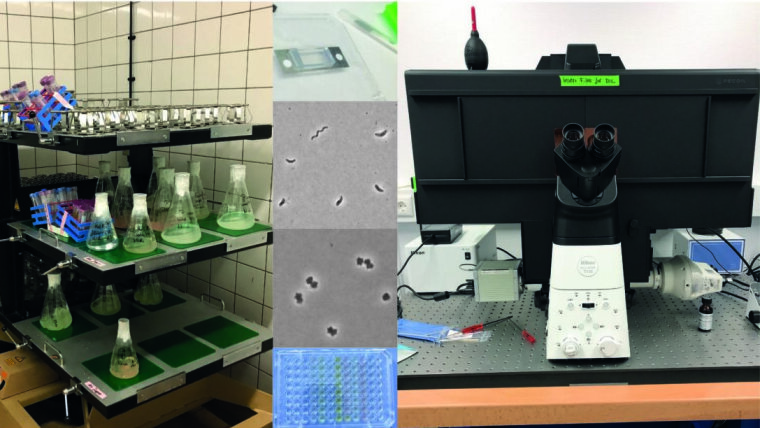

07743 Jena Google Maps site planExternal link
Research
The impressive ability of bacteria to thrive in very diverse environments as parts of multi-species communities is based on their enormous adaptivity. One highly understudied adaptive trait of bacteria is their morphology. In addition to revealing novel cell biological principles, the study of morphology has provided emerging evidence that cell shape impacts bacterial fitness and pathogenesis, thus significantly impacting physiology and community interactions.
At the Junior Research Group Prokaryotic Cell Biology, we want to contribute to this fascinating field. We therefore connect the fields of bacterial cell biology, molecular microbiology, biochemistry and physiology to study the following topics:
- The molecular mechanisms underlying bacterial cell shape.
- The molecular mechanisms bacteria use to modify their shape based on community interactions.
- The role of cell shape on microbe-host interactions.
- The potential of cell shape as a target for specific pro-/antimicrobial strategies.
Curriculum vitae Dr Muriel C. F. van Teeseling
| Period | Experience |
| 2021 | Junior Research Group Leader, Prokaryotic Cell Biology, Department of Microbial Interactions, Institute for Microbiology, Friedrich Schiller University Jena |
| 2017-2020 | Postdoc, Philipps-Universität Marburg, Germany |
| 2016 | Postdoc, Umeå Universitet, Schweden |
|
2011-2015 |
PhD, Ecological Microbiology, Radboud Universiteit Nijmegen, the Netherlands |
| 2006-2011 |
BSc & MSc Biology, Radboud Universiteit Nijmegen, the Netherlands |
Key publications
Messelink JJB, van Teeseling MCF, Janssen J, Thanbichler M, Broedersz CP (2021) Learning the distribution of single-cell chromosome conformations in bacteria reveals emergent order across genomic scales. Nat. Commun. in press.
van Teeseling MCF, Jogler C (2021) Cultivation of elusive microbes unearthed exciting biology. Nat. Commun. 12: 1-3.
van Teeseling MCF, Thanbichler, M (2020) Generating asymmetry in a changing environment: cell cycle regulation in dimorphic alphaproteobacteria. Biol. Chem. 401: 1349-1363.
Leicht O*, van Teeseling MCF*, Panis G, Reif C, Wendt H, Viollier PH, Thanbichler M (2020) Integrative and quantitative view of the CtrA regulatory network in a stalked budding bacterium. PLoS Genet. 16: e1008724. (* these authors contributed equally to this work)
Hartmann R*, van Teeseling MCF*, Thanbichler M, Drescher K (2020) BacStalk: a comprehensive and interactive image analysis software tool for bacterial cell biology. Mol. Microbiol. 114: 140-150. (* these authors contributed equally to this work)
Jung A, Raßbach A, Pulpetta RL, van Teeseling MCF, Heinrich K, Sobetzko P, Serrania J, Becker A, Thanbichler M (2019) Two-step chromosome segregation in the stalked budding bacterium Hyphomonas neptunium. Nat. Commun. 10: 3290.
Kremer K, van Teeseling MCF, Schada von Borzykowski L, Bernhardsgrütter I, van Spanning RJM, Gates AJ, Remus-Emsermann MNP, Thanbichler M, Erb T (2019) Dynamic metabolic rewiring enables efficient acetyl-CoA assimilation in Paracoccus denitrificans. mBio 10: e0080.
van Teeseling MCF, de Pedro MA, Cava F (2017) Determinants of bacterial morphology: from fundamentals to possibilities for antimicrobial targeting. Front. Microbiol. 8: 1264.
van Teeseling MCF, Mesman RJ, Kuru E, Espaillat A, Cava F, Brun YV, VanNieuwenhze MS, Kartal B, van Niftrik L (2015) Anammox planctomycetes have a peptidoglycan cell wall. Nat. Commun. 6: 6878.
van Teeseling MCF, Pol A, Harhangi HR, van der Zwart S, Jetten MSM, Op den Camp HJM, van Niftrik L (2014) Expanding the verrucomicrobial methanotrophic world: description of three novel species of Methylacidimicrobium gen. nov. Appl. Environ. Microbiol. 80: 6782-6791.
All publications: https://scholar.google.de/citations?user=VUrU4S4AAAAJ&hl=de&oi=aoExternal link